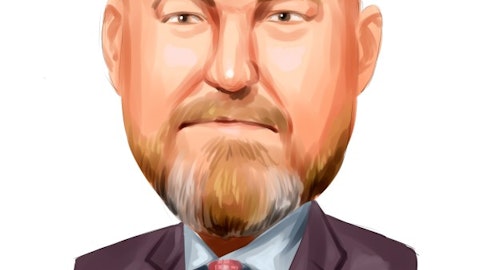Zumiez Inc. (NASDAQ:ZUMZ) Q2 2023 Earnings Call Transcript September 7, 2023
Operator: Good afternoon, ladies and gentlemen, and welcome to the Zumiez’s Inc. Second Quarter Fiscal 2023 Earnings Conference Call. [Operator Instructions]. Before we begin, I’d like to remind everyone of the company’s safe harbor language. Today’s conference call includes comments concerning Zumiez’s Inc. business outlook and contains forward-looking statements. These forward-looking statements and all other statements that may be made on this call that are not based on historical facts are subject to risks and uncertainties. Actual results may differ materially. Additional information concerning a number of factors that could cause actual results to differ materially from the information that will be discussed is available in Zumiez’s filings with the SEC. At this time, I would like to turn the call over to Rick Brooks, Chief Executive Officer. Mr. Brooks, the floor is yours.
Rick Brooks: Hello, everyone. And thank you for joining us on the call. With me today is Chris Work, our Chief Financial Officer. I’ll begin today’s call with a few remarks about the second quarter and the start of the back-to-school season before handing the call over to Chris, who will take you through the financials and some thoughts on the third quarter and the rest of the year. After that, we’ll open up the call to your questions. As you forecasted back in May, our results have continued to track below prior-year levels. That said, our second quarter sales improved from the previous quarter trend line and finished ahead of our guidance. The operating environment in the U.S. remains challenging with significant multiyear inflationary impacts weighing on consumer discretionary spending, continued competition with spending on travel and experiences, and higher levels of discounting to clear excess inventories.
While this backdrop does not set up well for our full-price selling model, we know from experience that these down cycles are temporary. And, our focus is on best positioning the business to capitalize on market conditions as market conditions improve. This means staying close to our customers, adjusting our assortments to ensure we have diverse and differentiated merchandise they seek, and providing the world-class customer service they’ve come to expect from us. While we’re not where we want to be from a results perspective, we made progress in the second quarter. And, the work we’ve done this year against the plan we outlined in our earnings in March has positioned the business for further improvement in the second half of 2023. The sequential moderation in our sales trend in Q2 has continued in the third quarter as we move into the back-to-school season and higher volumes.
Through Labor Day, third quarter-to-date sales are down 7.7% compared with down 11.6% in Q2 and 17.1% in Q1. Given that back-to-school has historically been a good indicator for holiday demand, we’re optimistic about continued improvement in the business through the peak selling period this coming holiday season. For the tough first half, but I’m confident that by staying the course, we will emerge from this turbulent period even stronger. This means being diligent with our spending, focusing on the strategic investments that we believe will create significant long-term benefits for our customers and our shareholders while managing carefully in the short term what we can control. Some of the long-term strategic investments we believe are important to push forward include continued investment in our people through best-in-class training and mentoring; optimizing trade area performance by ensuring that we have the right number of stores to serve our customers in each market and getting the right product in the right places to serve them as quickly as possible.
Continuing to work with brands to increase speed and flexibility, while increasing margins; investing in innovative approaches to generate human-to-human connections with our customers and engage with them in new ways that enhance the shopping experience; continuing our international expansion, with a focus on Europe and Australia. We know that brands emerge locally and grow globally, and our international presence provides us opportunity to better serve both our customers and our brand partners. While we continue to optimize these operations with many of the initiatives we have proven across North America, we feel good about the progress we made internationally this year, where first-half comparable sales in our other international businesses increasing 8% and total sales increasing over 14%.
Before I turn the call over to Chris, I would like to thank everyone in our organization for their continued hard work and dedication. You’re the foundation of our unique culture and the reason I’m certain that Zumiez’s history of delivering long-term value for its shareholders will continue for years to come. With that, Chris will now discuss the financials.
Chris Work: Thanks, Rick, and good afternoon, everyone. I’m going to start with a review of our second quarter results. I’ll then provide an update on our third quarter-to-date sales trends before providing some perspective on how we’re thinking about the full year. Second quarter net sales were $194.4 million, down 11.6% from $220 million in the second quarter of 2022. Comparable sales were down 13% for the quarter. The decrease in sales was primarily driven by our North America business, offset by more favorable results for our other international business. During the quarter, we continued to see softer sales, primarily driven by ongoing inflationary pressure, increased competition for discretionary spending, and higher levels of discounting in the market.
From a regional perspective, North American net sales were $159.7 million, a decrease of 15.9% from 2022. Other international net sales, which consist of Europe and Australia, were $34.8 million, up 15.5% from last year. Excluding the impact of foreign currency translation, North America net sales increased 15.7% and other international net sales increased 11.8% compared with 2022. Comparable sales for North America were down 15.8%, and comparable sales for other international were up 3.7% for the quarter. From a category perspective, all categories were down in comparable sales from the prior year during the quarter with hard goods being our most negative, followed by footwear, accessories, women’s and men’s. Total dollars per transaction were up for the quarter, driven by an increase in average unit retail, partially offset by a decrease in unit per transaction.
Second quarter gross profit was $61.7 million compared to $75.1 million in the second quarter of last year. Gross profit as a percentage of sales was 31.7% for the quarter compared with 34.1% in the second quarter of 2022. The 240-basis point decrease in gross margin was primarily driven by lower sales in the quarter, driving a deleverage on our fixed costs. The key areas driving this change were as follows: store occupancy costs deleveraged by 210 basis points on lower sales volumes, product margins decreased by 70 basis points, and buying and private label costs deleveraged by 20 basis points. These decreases to gross margin were partially offset by a decrease of 30 basis points in web shipping costs and a 30-basis point decrease in inventory shrinkage.
SG&A expense was $72.2 million or 37.1% of net sales in the second quarter compared to $70.1 million or 31.8% of net sales a year ago. The 530 basis point increase in SG&A expenses as a percent of net of sales was driven by the following: 210 basis point increase due to both deleverage of store wages on lower sales as well as increases in wage rates that could not be offset by hours reduction; 160 basis point increase due to deleverage of nonwage store operating costs; 80 basis point increase in non-store wages; and a 60 basis point increase in training and events due to event timing. Operating loss in the second quarter of 2023 was $10.5 million or 5.4% of net sales compared with operating profit of $5 million or 2.3% of net sales last year.
Net loss for the second quarter was $8.5 million or $0.44 per share. This compares to net income of $3.1 million or $0.16 per diluted share for the second quarter of 2022. Our effective tax rate for the second quarter of 2023 was 8.5% benefit compared with 44.7% provision for income taxes in the year-ago period. The decrease in our effective tax rate was primarily due to increase in net losses and allocation of those losses across the jurisdictions in which we operate. Turning to the balance sheet. The business ended the quarter in a strong financial position. We had cash and current marketable securities of $140 million as of July 29, 2023, compared to $166.2 million as of July 30, 2022. The $26.2 million increase in cash and current marketable securities over the trailing 12 months was driven primarily by capital expenditures of $27.3 million.
As of July 29, 2023, we have no debt on the balance sheet and continue to maintain our full unused credit facility. We ended the quarter with $156.7 million in inventory, up 3.7% compared to $151.1 million last year. Inventory growth was driven primarily by store count increases in our international business, while inventory in North America is down 3.5% from the prior year. On a current constant currency basis, our inventory levels were up 2.3% from last year. Now from — to our third quarter-to-date results. Net sales for the 37-day period ended September 4, 2023, decreased 7.7% compared to the same 37-day period in the prior year ended September 5, 2022. Comparable sales for the 37-day period in September 4, 2023, were down 8.6% from the comparable period in the prior year.
From a regional perspective, net sales for our North American business for the 37-day period ended September 4, 2023, decreased 10.1% over the comparable period last year. And, other international business increased 14.7% versus last year. Excluding the impact of foreign currency translation, North America net sales decreased 9.9% and other international net sales increased 8.5% compared with 2022. From a category perspective, the men’s category had a positive comp for the 37-day period ended September 4, 2023, while all other categories were negative. Footwear was our most negative category followed by women’s, accessories, and hard goods. Total dollars per transaction were up for the period, driven by an increase in both average unit retail and units per transaction.
With respect to our outlook for the third quarter of fiscal 2023, I want to remind everyone that formulating in our guidance involves some inherent uncertainty and complexity in estimated sales, product margin, and earnings growth given the variety of internal and external factors that impact our performance. Our Q3-to-date results have continued to show incremental progress to the trends experienced in the first and second quarter, but are still trending below year-ago levels as consumer demand remains under pressure from the continued impact of high inflation on discretionary spending. With that in mind, we are planning total sales for the third quarter will be between $211 million and $216 million. We expect that our third quarter 2023 product margins will be down slightly from the third quarter of fiscal 2022, due primarily to the mix of sales year-over-year.
Consolidated operating margins for the third quarter are expected to be between negative 1.5% and negative 2.5%. And we anticipate a loss of $0.15 to $0.25 per share. Similar to the first half, the decline in earnings is largely due to deleveraging the cost structure on a lower sales base, coupled with margin pressure. Our biggest areas of deleverage continue to be tied to fixed costs such as occupancy expense, base hours in our store that are driven by mall operating hours, fixed payroll costs across the business, and other corporate costs. As has been our practice this year, we are refraining from giving specific annual financial guidance due to the uncertainty and volatility in the macro environment, but I do want to provide some context around how we currently believe the business will trend throughout the year.
We have seen the trend line of sales results to the prior year get stronger as we have moved through 2023 and expect that to continue as we move through the back half of the year when compared to fiscal ’22 results. In fiscal 2022, product margins were down 50 basis points from the prior year after six consecutive years of growth. The majority of this year-over-year decrease was driven by our fourth quarter 2022 product margin, which was impacted by increased discounting as we work to right-size the inventory balance. We anticipate the front half of 2023 would also run down in product margin as we continue to work through aged inventory, and the market remains promotional. For the first six months of fiscal 2023, margin decreased 70 basis points from the first half of 2022, which included the mixed impact of our international business, which has a lower product margin and is growing as a percentage of total sales.
As we transition to the back half of the year, we believe that product margins could stabilize as inventories come in line and comparisons get easier. Our model is sensitive to sales fluctuations, and we have seen deleverage as sales decline in fiscal 2022 and also year-to-date in fiscal 2023, while the opposite was true in 2021 when we experienced record sales and operating margin driven by meaningful leverage. We continue to diligently manage expenses as we navigate this current environment and are positioned to take advantage when conditions improve. We have seen a reduction in our bottom line results during 2022 and 2023, creating significant variability in our consolidated tax rate. This is tied to the distribution of income across our current tax jurisdictions.
Given this, we are expecting a tax expense could be in excess of pretax income for the full year. We are planning to open 19 new stores during the year, including approximately five stores in North America, 10 stores in Europe, and four stores in Australia. We expect capital expenditures for the full 2023 fiscal year to be between $19 million and $21 million compared to $26 million in 2021 — 2022. We expect that depreciation and amortization, excluding noncash lease expense, will be approximately $23 million. We are currently projecting our share account for the full year to be approximately 19.5 million diluted shares. With that, operator, we’d like to open the call up for questions
See also Top 15 Sports Tech Companies And Startups In The World and 15 Countries That Care About The Environment Most.
Q&A Session
Follow Zumiez Inc (NASDAQ:ZUMZ)
Follow Zumiez Inc (NASDAQ:ZUMZ)
Receive real-time insider trading and news alerts
Operator: [Operator Instructions]. Our first question for today will be coming from Mitch Kummetz of Seaport. Your line is open.
Mitch Kummetz : Thank you for taking my question. I’ve got three of them. Chris, on the sales guide, I think the range you gave that has sales down. And I think that’s — let’s see here, 9% to 11%, and you’re running better than that quarter-to-date. So that obviously implies that you expect tougher results in the rest of September and into October. Could you maybe just address that? And I’m also curious, now that your kind of post-peak back-to-school, have you seen some softening maybe in the weekly numbers since possibly kind of mid-August?
Chris Work: Sure, Mitch. I’ll try to take a crack at that. So — and you’re right, the guide that we gave is down 9% to 11%, which is slightly worse than what our run rate has been. And I think as we’ve worked through August and kind of the back-to-school season, I would tell you, we are encouraged that our trend line has accelerated from where we were in Q2, but it was choppy. And I think it started a little softer. Weeks two and three were our best weeks and in the last couple of weeks have been a little bit softer. And we’ve looked at that a few different ways. Obviously, the timing of when different markets go back to school have some pull-on kind of what the overall results were. But we’re also looking at it from a greater sense of knowing the need base of back-to-school shopping and where that’s at.
And, our historical results would tell us that typically when you get out of peak, you’ll see a little bit less demand. And so, we’re sort of buffering the current run rate for that under the assumption of just kind of where the market’s at. And hopefully, as we try to do is it’s the guidance that we can beat.
Mitch Kummetz : Okay. And then I know you’re not providing specific guidance beyond 3Q, but you talked about kind of the improvement in the run rate. When I look at the trajectory on your sales growth down 17% 1Q, down 12% 2Q, the midpoint of 3Q is down 10%. Are you thinking that 4Q sales growth will land somewhere kind of in the, I don’t know, upper mid-to lower high single-digit negative range? Is that kind of the trajectory that you think the business is on?
Chris Work: Yes. I’m going to stay away from giving specific fourth quarter guidance. I think what I would say is this, as we look at Q4, we’ve historically been able to take a lot away from back-to-school, kind of in the trends of the business and what we’ve seen happening. And I’ll tell you, even though this is a softer back-to-school for us, we look back at the quarter-to-date and what we’ve learned and I think it would continue to tell us that we have a good trend line going into Q4. So, as we think about the sequential sales improvement from Q3 to Q4, we’re currently planning Q4, which should be much stronger than what we’ve seen from Q1 to Q2 and now from Q2 to the Q3 guidance that we’ve given. So, we do expect this trend line to improve.
Those beliefs are based on a few things: first, I think our continued ability to drive stronger results. I think as we kind of break down back-to-school, further, we’re really encouraged. Men’s is our largest category, 50% of the business, was our best-performing category in Q2. And then turned positive during back-to-school. And we view that as a really good, and good indicator for where the business is at. I mean, Mitch, you’ve followed the company for some time. I mean, if we look back at ’08 and ’09 and kind of how we climbed out of those times and even 2015 and 2016, which were softer for us, Men’s was a huge catalyst for that. So, I think we’re really encouraged by that. We’re encouraged by what we saw from the customer during the period.




